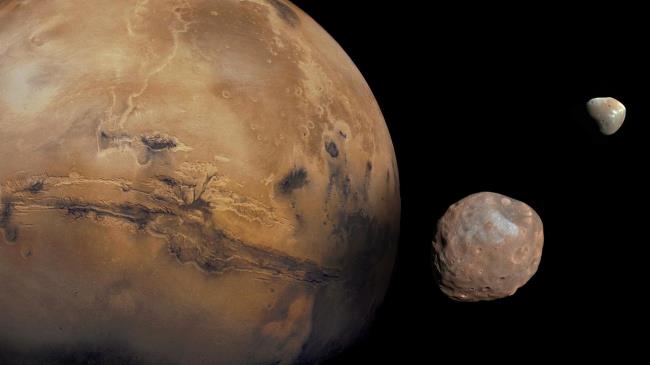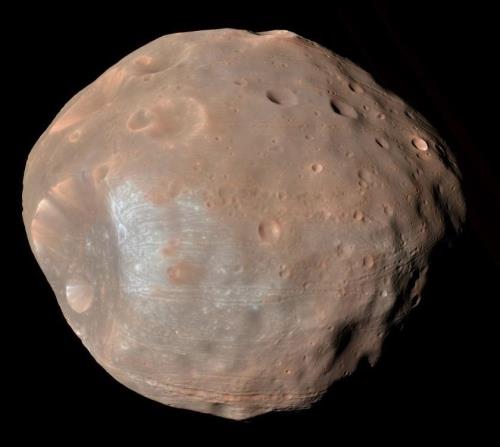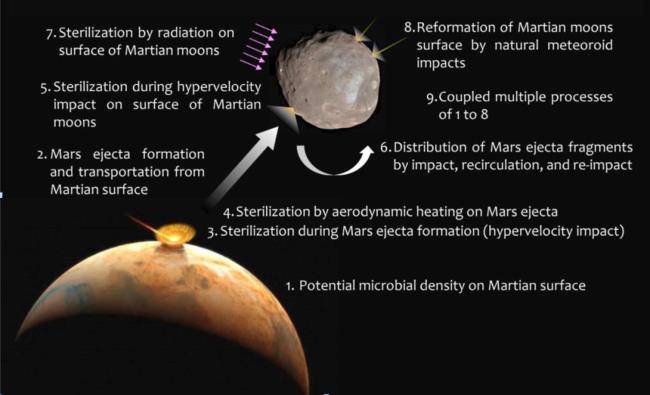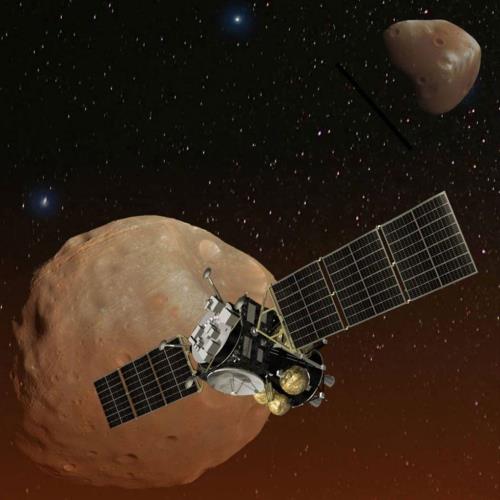Hidenori Genda and Mars’ moons

Mars with its two moons, Phobos and Deimos. Phobos orbits a mere 6,000 km above the surface, while Deimos is 24,000 kilometers away from the planet. In comparison, there is an almost 384,000 kilometers mean distance between the surface of the Earth and our elliptically orbiting moon. With the moons so close to Mars, debris from meteorite impacts on the planet can easily land on the moons. (NASA/JPL-Caltech/University of Arizona)
Sometime in the mid-2020s, the capsule of the Japanese Martian Moons eXploration (MMX) mission is scheduled to arrive at the moons of Mars – Phobos and Deimos.
These are small and desolate places, but the goal of the mission is large: to collect samples from the moons and bring them back to Earth.
If it succeeds, the return would likely be the first ever from Mars or its moons -- since planned sample return efforts from the planet itself will be considerably more challenging and so will take longer to plan and carry out.
The Mars moon mission has the potential to bring back significant information about their host planet, the early days of our solar system, and the origins and make-up of the moons themselves.
It also has the potential, theoretically at least, to bring back Martian life, or signatures of past Martian microbial life. And similarly, it has the potential to bring Earth life to one of the moons.
Under the general protocols of what is called “planetary protection,” this is a paramount issue and is why the Japan Aerospace Exploration Agency (JAXA) was obliged to assess the likelihood of any such biological transfers with MMX.
To make that assessment, the agency turned to a panel of experts that included ELSI planetary scientist, principal investigator, and associate professor Hidenori Genda.
The panel’s report to JAXA and the journal Life Sciences in Space Research concluded that microbial biology (if it ever existed) on early Mars could have been kicked up by incoming meteorites, and subsequently traveled the relatively short distance through space to land on Phobos and Deimos. However, the panel’s conclusions were unambiguous: the severe radiation these microbes would encounter on the way would make sure anything once living was now dead.

Hidenori Genda, an ELSI planetary scientist with a long-lasting interest in the effects of giant planetary impacts, such as the one that formed our moon. His work has also focused on atmospheres, oceans, and life beyond Earth. (Nerissa Escanlar)
“In our analysis, we calculate the possibility of biology on Mars and it spreading to the moons,” he said. “But we did not find conditions under which more than an insignificant amount of that possible life could survive on the moons. And so there is no danger of contamination when returning a sample from the moons.”
However, he said, there is a decent chance that microbial “dead bodies” from Mars are on the surface of the moons and could – if the mission gets lucky – be drilled or scooped up for the voyage back to Earth.
The science board recommended that the mission be designated “unrestricted Earth-return” by the Planetary Protection Panel of the international Committee on Space Research (COSPAR). And earlier this year that panel agreed with the JAXA assessment – which means there is less than a one-in-a-million chance that any living Mars microbe will exist in the sampling area on Phobos and Deimos.
In practical terms, the designation allows JAXA, and its international partners in the mission, to undertake their mission without extraordinary measures to protect the Earth and their sample on return.
In making their assessment, the JAXA-appointed panel hypothesized the potential concentration of microbes present on Mars by looking to analog environments on Earth – the Atacama Desert in Chile, as well as permafrost and dry sections of Antarctica.
Then they assessed if and how microbes in rocks in the Mars crater Zunil – where potential life would be relatively protected from deadly radiation – could be dispersed by an incoming meteorite, and then to what extent the ejecta would spread to the moons. Because they are both so close to their host planet – Phobos is the moon closest to its host planet in our solar system – they would no doubt have samples of Martian material, and perhaps of ancient Martian material when it was warmer and wetter on the planet, and had a much greater chance of being home to biology.

NASA’s Mars Reconnaissance Orbiter approached to within 6,800 kilometers of Phobos to capture this enhanced-color view of the moon. The color is from infrared, red, and blue-green channels on the camera, so it represents light shifted slightly longer in wavelength than human eyes can see, which emphasizes subtle colorations on the moon. (NASA / JPL / U. Arizona)
The JAXA team concluded that, while the spread of Mars materials to the moons could and probably would be substantial, 70 to 80 percent of the possible microbes were likely to be dispersed all over the moons’ surfaces and then rapidly sterilized by solar and galactic radiation.
The rest could be protected within larger ejected rocks and by thick layers of regolith in new craters on the moons created by the in-coming Mars rocks.
But all told, the chance of microbes being present would be 1,000 to 10,000 times less than in the Mars crater – where none may exist at all anyway.
The COSPAR Category V designation (unrestricted Earth-return because the moons are considered to have “no indigenous life forms”) will permit JAXA to use a range of regolith-collection techniques if they meet certain conditions. They can, for instance, use a coring device that can drill down 8 centimeters to collect up to 100-gram samples from Phobos.

The various steps of Martian material transferred to Phobos (and inferred for Deimos). The SterLim (Sterilisation Limits for Sample Return Planetary Protection Measures) and JAXA (Japan Aerospace Exploration Agency) teams undertook experimental studies or numerical modeling to study each distinct step in the chain from the surface of Mars to that of its moons. The JAXA team presented their findings to the committee and it organized its report around the various steps outlined here. (A. Yamagishi and K. Fujita, JAXA)
Genda has been officially involved in the MMX project since 2016 as a member of an official JAXA MMX Science Board.
He said his ongoing role is to maximize the scientific results from MMX – to write papers, do additional research and, in keeping with the ELSI approach, facilitate interdisciplinary work.
His Science Board work includes at least one teleconference a week with other Japanese scientists involved with the MMX project, as well as scientists from the three cooperating space agencies – NASA, the France’s National Centre for Space Studies (CNES) and German Aerospace Center (DL.R). He said he has already logged more than 200 of these teleconferences, and it’s still five years until the launch. The Board will remain in place until 2030, after the mission ends.
Genda has written many papers for the Board already, including his theoretical work on the formation of Phobos and Deimos as a result of an ancient giant impact from a Pluto-sized object.
He said his role is to support JAXA, which he said is busy making rockets and instruments. “They don’t have much time for science,” he said. “That goes mostly to outside scientists, university folks.”
One exception is Tomohiro Usui, formerly of ELSI. He is also working on the MMX project, and will play a key role handling, and making initial analysis and classification of the sample when it returns. But at best, that won’t be for another decade.
Another scientist associated with ELSI – Genda’s postdoc Ryuki Hyodo – moved to JAXA in October and will work on the MMX and BepiColombo mission to Mercury.

Genda and Ryuki Hyodo at ELSI. (Nerissa Escanlar)
The two moons – Phobos (fear) and Deimos (panic) – are named after the horses that pulled the chariot of the Greek war god Ares, the counterpart to the Roman war god Mars.
A heated debate regarding the moons – and a central question for MMX to hopefully resolve – involves how the two moons formed. Two schools argue very different scenarios: that the two moons are actually asteroids that once orbited the sun between Mars and Jupiter, or that they were formed by a giant impact as with our moon.
The martian moons appear to have regolith (surface materials) that resembles that of many asteroids in the outer belt. This has led some scientists to argue that Phobos and Deimos are “captured asteroids.” After a collision in the asteroid belt, the two could have scattered inward toward the sun and were ultimately captured and put into orbit by the gravity of Mars.

Artist rendering of MMX as it approaches Phobos and Deimos. Phobos is 22.2 kilometers in diameter while Deimos is but 12.6 kilometers. (JAXA/NASA)
In the late stages of the formation of our solar system, giant impacts such as the one that struck the Earth were not unusual. Genda’s work suggests that Mars shows evidence for one such collision as well.
His view is, in part, a result of the fact that the surface of the northern hemisphere of Mars lies an average of 5.5 km lower than the southern hemisphere. This suggests that it was hit long ago by a relatively large body which would have ejected enough martian material to lead to the formation of the moons.
The orbit of the two moons around the equator of Mars also suggests a birth by impact rather than asteroid capture since it would be very difficult for captured asteroids to attain those kinds of orbits.
Searching for evidence that can resolve the moon origin question is a primary goal for the MMX mission. If the moons were formed from portions of Mars itself, then rocks collected on the moons could offer important insights into the rocks of Mars. Alternately, if scientists conclude that the moons are captured asteroids, they would have formed elsewhere in the solar system and would contain information that is different, but potentially just as important.
Both possibilities could add to our understanding of the formation of our solar system. If Phobos and Deimos formed during these early times, for instance, the moons could provide a window into conditions on early Mars. And since Mars and Earth were by all accounts far more similar in their very early days than they are now, new insights into early Mars would help us understand the formation of the Earth and potentially how it became habitable.
The habitability question explains why planetary protection is so important: if spacecraft from Earth were to bring microbes to any object in space, there is always the possibility – however remote – that the microbe could survive and spread. From a scientific perspective, any Earth contamination could forever change Mars and Mars moon exploration and science.
The MMX mission has a “forward” planetary protection rating of Category III, which requires more protective steps than the Category II designation for Hayabusa2, which is now at the asteroid Ryugu. This is primarily because of concerns over what could happen if the MMX spacecraft malfunctioned and crashed into Mars, as well as the need to protect the unlikely presence of biology on the moons. Genda said that his group has not addressed the issue of “forward” contamination and that it is an engineering rather than a scientific issue.
As for “back” contamination of Earth from possible martian or other microbes in a returned sample, the consequences could be significant. That’s why Genda and JAXA were so pleased to report that the possibility of that kind of contamination from the Mars moon mission is vanishingly small.
------
Marc Kaufman has written books on astrobiology and Mars, has been a longtime reporter at The Washington Post and The Philadelphia Inquirer, and writes the NASA-supported online column Many Worlds (www.manyworlds.space) He has also had the good fortune to visit and work at ELSI numerous times and he wrote "ELSI RISING" -- the story of ELSI's origins and evolution -- in 2017.
